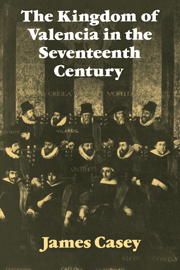Book contents
- Frontmatter
- Contents
- List of illustrations
- Preface
- Abbreviations
- A note on measures
- Map of the kingdom of Valencia
- Introduction
- 1 A long depopulation
- 2 Rich and poor
- 3 The decline of agriculture
- 4 Paying their way in the world
- 5 The seigneurial reaction
- 6 The bankruptcy of the senyors
- 7 The eclipse of the Popular Estate
- 8 The rule of the judges
- 9 Outlaws and rebels
- 10 The loyal kingdom
- Conclusion
- Appendix 1 Fluctuations in the tithes 1500–1700
- Appendix 2 The exploitation of a Valencian senyoriu: the marquesate of Lombay 1559–1700
- Appendix 3 Approaches to a budget for the Dukes of Gandía 1605–99
- Appendix 4 List of viceroys 1598–1700
- Bibliographical note
- Index
4 - Paying their way in the world
Published online by Cambridge University Press: 03 May 2010
- Frontmatter
- Contents
- List of illustrations
- Preface
- Abbreviations
- A note on measures
- Map of the kingdom of Valencia
- Introduction
- 1 A long depopulation
- 2 Rich and poor
- 3 The decline of agriculture
- 4 Paying their way in the world
- 5 The seigneurial reaction
- 6 The bankruptcy of the senyors
- 7 The eclipse of the Popular Estate
- 8 The rule of the judges
- 9 Outlaws and rebels
- 10 The loyal kingdom
- Conclusion
- Appendix 1 Fluctuations in the tithes 1500–1700
- Appendix 2 The exploitation of a Valencian senyoriu: the marquesate of Lombay 1559–1700
- Appendix 3 Approaches to a budget for the Dukes of Gandía 1605–99
- Appendix 4 List of viceroys 1598–1700
- Bibliographical note
- Index
Summary
‘We in this city and kingdom of Valencia’, the committee of the Estates reminded Philip IV, ‘live for the most part by trade, and on the victuals and merchandise brought from other realms.’ This brave declaration, contradicting any facile assumption that the Valencians lived wholly within a subsistence economy, was founded on the notorious fact that the kingdom could not feed itself. ‘Our wheat harvest is so small’, wrote one viceroy in 1609, ‘that it does not last half the year.’ Two centuries later the geographer Cavanilles was to arrive at a remarkably similar assessment: ‘the kingdom hardly grows enough wheat to feed its big population for six months of the year’. Though the expulsion of the Moriscos might seem to have eased the pressure for a while, the deficit in fact remained a major feature of the seventeenth-century economy. For the prime culprit was the great city of Valencia, which was still consuming – even when its population had fallen to around 10,000 households – some 36,500 cahizes (say 73,000 hectolitres) of wheat a year, most of which had to be imported from overseas.
But it was not simply a question of the bread supply; the dependence of the Valencians on outside supplies of essential food and materials was fatal. ‘For the provisioning of this city with meat’, declared the magistrates in 1629, ‘more than 80,000 head of sheep are needed every year’, almost all of which, given the underdevelopment of Valencia's pastoral economy, had to come from the meseta.
- Type
- Chapter
- Information
- The Kingdom of Valencia in the Seventeenth Century , pp. 79 - 100Publisher: Cambridge University PressPrint publication year: 1979



